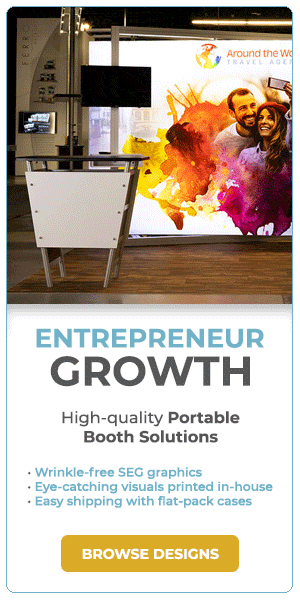
Event season is on its way!
As everyone gears up for what is set to be the most normal year of the 2020s, it’s important to not have a “normal” marketing strategy–especially if you’re attending trade shows or conferences.
How do you know if your marketing strategy is “normal”? Simple. You can expect your trade show marketing campaign to struggle if you’re attending for the following conventional reasons:
- “We’ve always gone to this show.”
- “Our competitors will be there.”
- “Our customers will miss us if we are not there.”
The problem with these justifications is not only that they are the majority opinion, but that none of them assume going to trade shows is a profitable method for lead generation. As a result, you drag your feet to attend and stumble upon arrival.
With the right strategy, you can increase your leads as well as brand awareness, recognition, and loyalty at trade shows and other face-to-face events. The first step in developing the right strategy is learning the laws. To start, here are the 3 most important, immutable laws of marketing for trade shows.
1. Law of Limited Prospects
You don’t have to be everything to everybody. For some reason, many marketers believe casting the widest net possible is an effective strategy for obtaining leads. However, at trade shows, a booth filled with people is only good if it is filled with buyers. Yes, “The customer is always right” is a good rule to follow. Just make sure it’s your customer who you are actively listening to.
So get focused on who your customers are. That’s the first law. Limit your prospects. Once you’ve done that, typically 15-30% of your targeted audience will be at the show, making your strategy much more focused. And there is another way to further limit your prospects: ranking. Not every lead is the same. Rank them according to A, B, and C leads:
- A leads are prospects with purchasing authority that will buy within the next 6 months
- B leads are prospects that have influence with someone who has purchasing authority that will buy within the next 6 months
- C leads are new people being introduced to your products and services for the first time
Of course, develop your own ranking system. But the point is to be specific with your target audience. This information is essential for writing specific, measurable goals and optimizing your performance at trade shows.
2. The Law of First in Line
Another thing marketers do that isn’t the best practice is talk about how their product is “the best.” The evidence is all around that getting there first is more important. Why? Because marketing is a battle for the mind. If you get in the prospect’s mind first, then you own the idea for the product or service.
A great example is voice recognition software. Since the iPhone introduced Siri, the program has been synonymous with voice recognition software. Microsoft’s Cortana trails behind despite being a quality product for phones and computers comparable to Siri. It wasn’t until Amazon introduced a new category, smart speakers, that another voice recognition software could seriously compete. Amazon’s Echo was the first smart speaker to hit the market in 2014. Since that time, Amazon has not only dominated the market for smart speakers (because it invented the category), but Alexa is now highly competitive against Siri.
Even though voice recognition has been around since the iPhone’s Siri, when used with different equipment, a new category and thus, a new market, appears. The biggest corporations understand the necessity of getting into the prospect’s mind first by creating new categories. Google has recently surpassed Amazon’s Echo by remarketing their Google Nest not as a smart speaker, but as a smart home.
So how does this law relate to trade shows specifically?
First, understand that trade shows are excellent training grounds to determine whether you have a truly unique product–the first of its kind. Second, this applies to your trade show display itself. Having a new experiential element that isn’t another photo booth or product demo can help attract the prospects you’re trying to influence.
3. The Law of Resources
Because marketing is a battle for the prospect’s mind, you need money. Minds are expensive. And the only way to get in there is to fight for their attention. That’s why we believe “If you can capture an eye, you can open a mind.”® Social media marketers understand that the number one commodity they deal in is attention. The same goes for trade show marketers.
It’s vital to not skimp on this. If you have a great idea but no way of gaining an audience you’ll fall behind someone with a mediocre idea with a big platform.

The Trade Group is a full-service trade show and event marketing company. We will work with you to create an exhibit or an event that brings in leads and helps you achieve your business goals. Contact us here or give us a call at (800) 343-2005.



